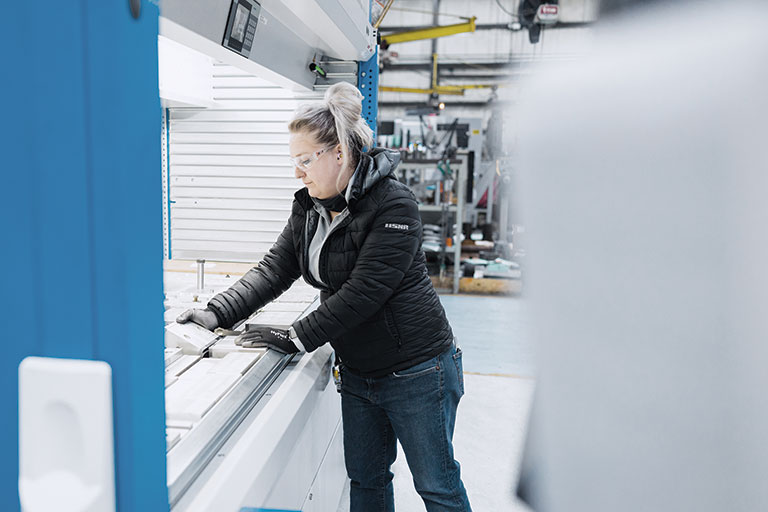USNR implements VLMs to save floor space
OEM manufacturer recovered 92% of its floor space.

An OEM manufacturer in the wood processing industry, USNR supplies systems and service to wood processing companies around the world, from sawmills and planer mills to plywood and panels.
In addition to manufacturing equipment, the company, headquartered in Woodland, Wash., also provides replacement parts and support around the clock. As business grew, USNR sought to implement a more efficient, automated manufacturing process.
Interested in upgrading its manufacturing plant, while organizing and scheduling projects, reducing idle time and maximizing productivity, USNR considered installing a Fastems flexible manufacturing system (FMS). However, there was not any available space for the system.
To find space to add the new automated manufacturing system and modernize its plant, USNR decided to first focus on consolidating the warehouse storage. Warehouse parts were stored on shelving, which was situated under a second level mezzanine that was accessible from an elevator. Tooling and raw materials were stored in cabinets and shelving throughout the facility, which was time inefficient.
“Adding more shelving to increase capacity within the facility would only take up more space,” says Mike Smothers, operations manager at USNR. “I had to go up—not out.”
Phase one of the warehouse redesign integrated two 30-foot Shuttle XP vertical lift modules (VLMs), integrated with Power Pick Global (PPG) inventory management software to consolidate warehouse parts storage. All of the small parts stored on shelving, as well as within the mezzanine, were moved into the two VLMs.
“These two units allowed me to get rid of the shelving and mezzanine entirely. We needed to make room for the FMS systems and be able to roll the warehouse around throughout the project as the entire facility was going to be rearranged,” Smothers says.
The VLMs store roughly 2,500 SKUs. These parts are used to fill customers’ parts orders, spares orders and transfer orders. In addition, the VLMs store parts for capital production projects. By consolidating all of the parts inventory into these units, the plant saved 92% floor space, as it eliminated the shelving and mezzanine to make room for the new FMS system.
Sales orders come in throughout the day from customers needing spare parts or part replacements, as well as transfer orders from other USNR facilities. The warehouse also receives production orders’ capital projects. Both orders come in through Microsoft AX and push to the PPG inventory management software. The VLM operator can then batch orders into groups in the PPG software before the picking process starts. Once the orders are organized into a batch—with the push of a button—the Shuttle XP moves to deliver the first tray. An inserter extractor then runs up and down the middle of the unit, which retrieves a tray from either the front or back of the VLM, depending on where the items are stored. Afterward, items are picked from the tray, and it is returned to storage.
This process continues until all parts for the batch are picked. After the picking process is completed, sales orders are either sent to shipping or crating to be packaged with other larger inventory. Orders for capital production are then routed to the kitting area where they’re held until the assembly start date.
USNR operates two 4 to 10 shifts, along with a weekend shift Friday through Sunday, which helps the manufacturer meet fast delivery times. Since implementing the VLMs, USNR’s lead times have been reduced from an average of 25 days to its current average of eight days—with a goal of five days of average lead time by the end of the year.
Since the VLMs operate on the goods-to-person principle, stored inventory is provided directly to the operator, eliminating the need to walk to and search shelving for parts. Employees don’t need to go up and down the elevator to access parts in the mezzanine, which saves time and increases productivity. USNR has been able to reduce warehouse labor by 40%.
“The Shuttle XP VLMs were the first big move toward a more automated facility,” Smothers adds.
Systems Integrator: Kardex Remstar
(800) 639-5805

Article Topics
Kardex Remstar News & Resources
The Future of Work in Intralogistics Van Meter: Saving space while increasing throughput Van Meter optimizes with vertical lift modules (VLMs) Automated storage carries benefits inside and out Kardex Solutions and Tompkins Robotics enter partnership Order Picking Strategies Warehouse Insights: Tackling Space in Micro-fulfillment More Kardex RemstarLatest in Materials Handling
NetLogistik partners with Vuzix subsidiary Moviynt to offer mobility solutions for warehouses Materials Handling Robotics: The new world of heterogeneous robotic integration Lucas Watson appointed CSO for Körber’s Parcel Logistics business in North America Hyster recognizes Dealers of Distinction for 2023 Carolina Handling names Joe Perkins as COO C-suite Interview with Keith Moore, CEO, AutoScheduler.AI: MODEX was a meeting place for innovation Walmart deploying autonomous lift trucks at four of its high-tech DCs More Materials HandlingAbout the Author
Subscribe to Materials Handling Magazine

Find out what the world's most innovative companies are doing to improve productivity in their plants and distribution centers.
Start your FREE subscription today.
April 2024 Modern Materials Handling

Latest Resources










